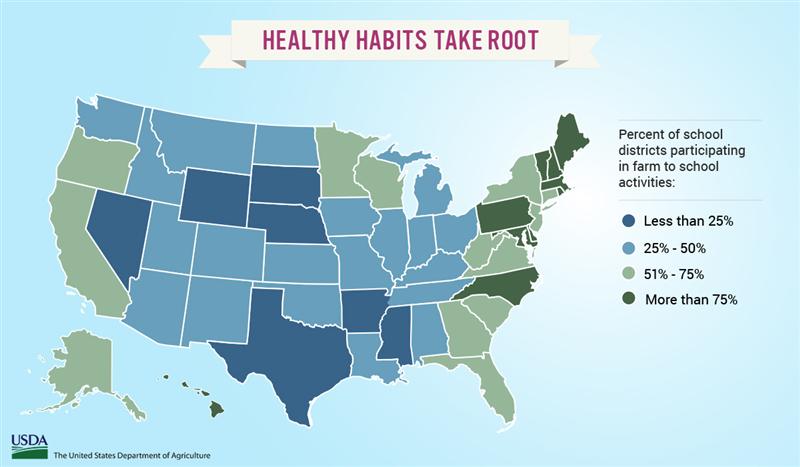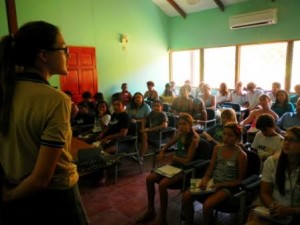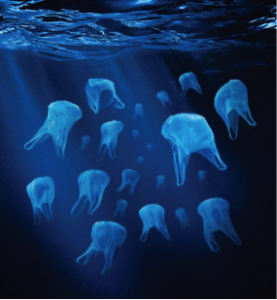 Take a look at the map above. What do you notice?
Take a look at the map above. What do you notice?
Although 42% of school districts had farm-to-school programs in 2015, a closer look reveals significant inequalities across states. The number of school districts with farm-to-school programs was 100% in Rhode Island and Hawaii but just 14.9% in Arkansas.
This gap is significant since farm-to-school participation is a good indication of the accessibility of locally sourced, fresh foods in school meals and these programs are known to positively impact both the local economy and the environment.
A new study by Helena Lyson, a researcher at the University of California, Berkeley, seeks to understand what accounts for these disparities. She found that the most important factors were wealth and peer pressure, meaning that these programs are still leaving behind those who could benefit from them the most.
The National School Lunch program has a complicated history. It was initially established to improve nutrition, especially among the poor, and increase domestic consumption of U.S. agricultural products, but these goals have been compromised. Unhealthy, processed, and pre-packaged foods made their way into lunchrooms in the 80’s, when budget cuts led many schools to contract with private food service companies. Schools in lower-income communities were more likely to require these contracts as the budget cuts hit them the hardest. Thus, a program initially established to address in-equality began to exacerbate it, by providing unhealthy food to those who could not afford anything better.
Change seemed to be finally on the horizon in 2010. The Healthy, Hunger-Free Kids Act of 2010 created nutrition standards for all foods sold in schools. It also provided $5 million dollars annually to support competitive grants for farm to school initiatives across the country. Farm-to-school activities include incorporating local foods into school meals, nutrition or agriculture-based activities in classrooms, field trips to farms or farmers markets, and school garden programs. The grant program is highly competitive. In 2013 the USDA awarded funding to only 19% of applicants. The 65 programs established by these grants are estimated to have involved 1.7 million students in 3,200 schools nationwide.
Although the distribution of these grants is supposedly unbiased, the results of the study clearly indicate that the process is favoring wealthier states in the Northeast, where farm to school participation is already high. Vermont received the most funding at $1.02 per student, while Texas received the least at just $0.009 per student. Thirteen states received no funding at all. How are poorer states expected to catch up if all of the funding is going to the rich?
The states with the highest average income per resident, Connecticut and Maryland, are ranked 3rd and 12th in farm to school participation. Meanwhile, the states with the lowest average income per resident, Mississippi and Arkansas, are ranked 47th and 51st. It is not entirely surprising that wealthier states have higher farm to school participation. Wealthier school districts have more money to devote to these programs, their teachers can devote time to activities outside the required curriculum, and they might even have someone to help with the grant writing process.
The fact that peer pressure is a predictor of farm to school participation is somewhat unexpected. Peer pressure in this context means that states mimicked the behavior of their neighbors. States in regions with high farm-to-school participation were more likely to also have high participation. The regions in this case refer to those designated by the Sustainable Agriculture Research & Education (SARE) program, shown on the map above. However, the power of peer pressure varied from region to region; states in the North Central region had the widest range of farm to school participation, while the participation of states in the Northeast was similar to that of their neighbors. This difference may be due to the fact that states in the Northeast are smaller and the population is more concentrated than in the North Central region.
By allowing wealth and peer pressure to drive growth in farm-to-school programs, the grant-based system is reinforcing existing inequalities. Under this framework, the South, a poor region of the country where the few farm to school programs exist, and where children already have the highest obesity rates in the country, is at a particular disadvantage.
To create a more just food system, poorer states need better access to farm-to-school grants. Considering the regional peer pressure effect shown in the study, increasing the farm-to-school rate in even one state in a region without many farm-to-school programs could encourage other states to follow their lead. Therefore, lower income states and school districts should be given priority to receive more funding. Furthermore, efforts should be made to help them with the grant writing process and implementation of farm-to-school programs. Farm-to-school will not be the solution it promises to be if it continues leaving the poorer half of the country behind.
































